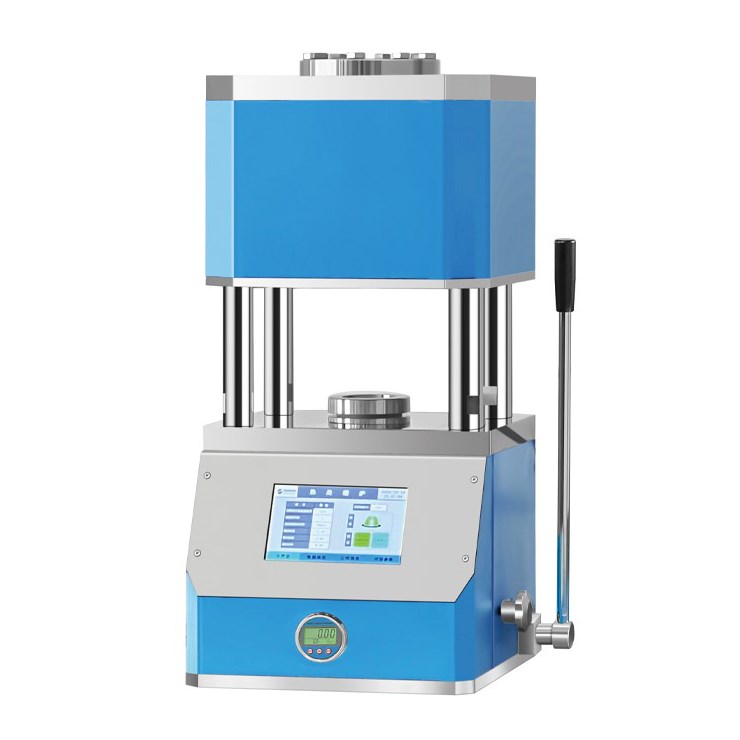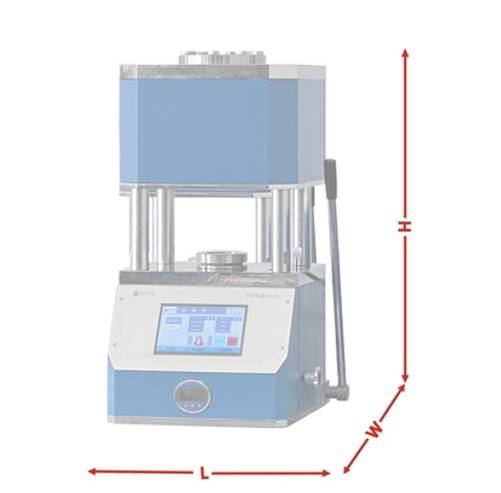
Customer-made Press
Manual High Temperature Heated Hydraulic Press Machine with Heated Plates for Lab
Item Number : PCHT
Price varies based on specs and customizations
- Pressure process
- Manual pressurization
- Pressure holding time
- 1 second ~ ∞ seconds
- Cylinder stroke
- 80mm
- Heating temperature
- Maximum 1000℃
Shipping:
Contact us to get shipping details Enjoy On-time Dispatch Guarantee.
Why Choose Us
Reliable PartnerEasy ordering process, quality products, and dedicated support for your business success.
Introduction
The High Temperature Hot Press is a machine specifically designed for pressing, sintering and processing materials in a high temperature environment. It is capable of operating in the range of hundreds of degrees Celsius to thousands of degrees Celsius for a variety of high temperature process requirements. Manual intervention is required to regulate and control pressure, temperature and other parameters during operation.
Applications
High temperature hot presses are widely used in the following areas:
High-temperature alloy manufacturing: used to manufacture aero-engine components, spacecraft materials, etc.
Powder metallurgy: used for manufacturing precision parts and metal products with complex structure.
Ceramic materials: used for sintering and processing of high temperature ceramics.
Electronic materials: for manufacturing semiconductor materials and magnetic materials.
Detail&part



- Step 1: Select the data screen and enter the setting interface
- Step 2: Select "Programmable segment setting"
- Step 3: There are 20 temperature rise control programs in the program, select the first segment
- Step 4: According to the experimental requirements, set the temperature and heating speed of the first segment
- Step 5: If multiple temperature rise programs are required, you can set the 20 segments
- Step 6: After setting, press the main interface to return to the operation interface
- Step 7: On the main interface, press "Heating Start".
- Step 8: The equipment starts to heat up according to the program.
- Step 9: The equipment stops automatically after heating. If the setting is wrong, such as the set temperature is not reached within the specified time, the equipment will automatically terminate.
Principle
High-temperature hot presses utilize the physical and chemical effects of high-temperature and high-pressure environments to press, sinter, and process materials by applying high pressure and temperature to the materials, prompting the rearrangement or crystallization of the material molecules. Under high temperature conditions, the material atoms can cross the energy barriers more easily, which is conducive to chemical reactions, grain growth and material densification, and thus improve the mechanical properties and heat resistance of the materials, as well as the manufacture of complex structural materials.
Feature
High-temperature operating capability: Capable of stable operation at extremely high temperatures, up to thousands of degrees Celsius.
Precise control: Equipped with precise temperature control and pressure control systems to ensure accurate and repeatable processing.
Adaptation to diverse materials: capable of handling various types of materials, including metals, ceramics, composites, etc.
High performance: equipment design and process optimization allow for high productivity and the ability to produce high quality products in large quantities.
Technical specifications
| Instrument model | PCHT |
|---|---|
| Pressure range | 0-5.0 tons |
| Pressure process | Manual pressurization |
| Pressure holding time | 1 second ~ ∞ seconds |
| Cylinder stroke | 80mm |
| Heating temperature | Maximum 1000℃ |
| Mold material | Nickel-based alloy (high temperature resistant material) |
| Sample size | Medium 10-30mm |
| Mold shape | Medium 50x90mm |
| Furnace diameter | Medium 60mm |
| Complete machine size | 400x380x780 (LxWxH) |
| Power supply | 220V 50Hz |
| Powder tablet press size diagram |  |
Operation steps

1.Place the sample into the mold.

2.Put the mold into the hot press.

3.Pre-press the sample.

4.Click on the data screen to set the heating temperature.

5.In the data screen, up to 20 heating programs can be set, and the heating speed can be adjusted.

6.Return to the main interface and start heating.

7.When the temperature reaches the set temperature, start pressurization.

8.Return to the main interface and start heating.
FAQ
What Are The Advantages Of Using A Hydraulically Heated Laboratory Press?
What Is Mpcvd?
What Does A Hydraulic Lab Heat Press Do?
What Is Mpcvd Machine?
What Types Of Samples Or Materials Can Be Processed In A Hydraulically Heated Laboratory Press?
What Are The Advantages Of Mpcvd?
How Does A Hydraulically Heated Laboratory Press Work?
Are CVD Diamonds Real Or Fake?
How Can The Performance Of A Hydraulically Heated Laboratory Press Be Optimized?
4.7
out of
5
Incredible precision and control, perfect for our lab's needs!
4.8
out of
5
Fast delivery and top-notch quality, highly recommend!
4.9
out of
5
Durable and reliable, a game-changer for our projects.
4.7
out of
5
Value for money, exceptional performance and durability.
4.8
out of
5
Technologically advanced, simplifies our complex processes.
4.9
out of
5
Ergonomic design and user-friendly, a breeze to operate.
4.7
out of
5
Highly satisfied with the speed and efficiency of this press.
4.8
out of
5
Excellent build quality, stands up to rigorous lab use.
4.9
out of
5
Innovative features make this a must-have for any lab.
4.7
out of
5
Quick setup and easy operation, saves us time daily.
4.8
out of
5
Robust and efficient, handles high-temp jobs flawlessly.
4.9
out of
5
Outstanding customer service and product support.
4.7
out of
5
Impressive durability, a key asset for our lab operations.
4.8
out of
5
Highly precise, critical for our sensitive material experiments.
4.9
out of
5
Exceptional value, enhances our lab's productivity significantly.
4.7
out of
5
Reliable and consistent, a staple in our lab equipment.
4.8
out of
5
Advanced technology at an affordable price, couldn't be happier.
REQUEST A QUOTE
Our professional team will reply to you within one business day. Please feel free to contact us!
Related Products

Manual Heated Hydraulic Press Machine with Heated Plates for Laboratory Hot Press
The Manual Heat Press is a versatile piece of equipment suitable for a variety of applications, operated by a manual hydraulic system that applies controlled pressure and heat to the material placed on the piston.

Automatic High Temperature Heated Hydraulic Press Machine with Heated Plates for Lab
The High Temperature Hot Press is a machine specifically designed for pressing, sintering and processing materials in a high temperature environment. It is capable of operating in the range of hundreds of degrees Celsius to thousands of degrees Celsius for a variety of high temperature process requirements.

24T 30T 60T Heated Hydraulic Press Machine with Heated Plates for Laboratory Hot Press
Looking for a reliable Hydraulic Heated Lab Press? Our 24T / 40T model is perfect for material research labs, pharmacy, ceramics, and more. With a small footprint and the ability to work inside a vacuum glove box, it's the efficient and versatile solution for your sample preparation needs.

Vacuum Hot Press Furnace Machine Heated Vacuum Press
Discover the advantages of Vacuum Hot Press Furnace! Manufacture dense refractory metals & compounds, ceramics, and composites under high temp and pressure.

Customer Made Versatile CVD Tube Furnace Chemical Vapor Deposition Chamber System Equipment
Get your exclusive CVD furnace with KT-CTF16 Customer Made Versatile Furnace. Customizable sliding, rotating, and tilting functions for precise reactions. Order now!

Square Lab Press Mold for Laboratory Applications
Create uniform samples easily with Square Lab Press Mold - available in various sizes. Ideal for battery, cement, ceramics, and more. Custom sizes available.

KT-PE12 Slide PECVD System: Wide power range, programmable temp control, fast heating/cooling with sliding system, MFC mass flow control & vacuum pump.

Easily release samples from our lab infrared press mold for accurate testing. Ideal for battery, cement, ceramics, and other sample preparation research. Customizable sizes available.

Learn about Cylindrical Resonator MPCVD Machine, the microwave plasma chemical vapor deposition method used for growing diamond gemstones and films in the jewelry and semi-conductor industries. Discover its cost-effective advantages over traditional HPHT methods.

Discover precision polygon press molds for sintering. Ideal for pentagon-shaped parts, our molds ensure uniform pressure and stability. Perfect for repeatable, high-quality production.

Square Bidirectional Pressure Mold for Lab Use
Discover precision in molding with our Square Bidirectional Pressure Mold. Ideal for creating diverse shapes and sizes, from squares to hexagons, under high pressure and uniform heating. Perfect for advanced material processing.
Related Articles

The Physics of Flawless Materials: Deconstructing the Hydraulic Hot Press
Discover how the synergy of Pascal's Law and thermal energy in a hydraulic hot press enables precise, repeatable material bonding and forming.

More Than a Squeeze: The Physics and Psychology of the Hydraulic Hot Press
An insight into the hydraulic hot press, where Pascal's Law meets thermodynamics to reshape materials. A story of force, heat, and control.

Why Your Composite and Polymer Parts Keep Failing: The Secret Is Simultaneous Heat and Pressure
Struggling with inconsistent composite or polymer bonding? Discover why separate heating and pressing fails and how a hot hydraulic press ensures repeatable, high-quality results.

Precision Under Pressure: The Physics and Psychology of the Hydraulic Hot Press
Discover how the synergy of heat and pressure in a hydraulic hot press transforms materials, guided by the elegant physics of Pascal's Law.

Beyond the Furnace: How Pressure Unlocks Ultimate Ceramic Performance
Hot pressing combines heat and pressure to overcome the limits of traditional sintering, creating near-perfectly dense ceramics with superior strength.

Density Is Destiny: The High-Stakes Physics of Hot Pressing
Hot pressing merges heat and pressure to forge ultra-dense materials, trading manufacturing speed for unmatched performance in complex components.

When Failure is Not an Option: The Physics of Hot Press Forging
Hot press forging trades dimensional precision for superior strength, creating complex, failure-resistant metal parts for critical applications.

Beyond the Furnace: How Hot Pressing Unlocks Near-Perfect Material Density
Explore how hot pressing combines heat and pressure to overcome traditional sintering, achieving superior density and strength in advanced materials.

The Quiet Force: Forging Superior Metal Components with Controlled Pressure
Discover how hot press forging uses slow, continuous pressure to refine a metal's grain structure, creating parts with unparalleled strength and reliability.

Why Your Molded Parts Fail: The Hidden Truth About Heat and Pressure
Struggling with warped or inconsistent parts? Learn why pressure isn't the problem and how precise thermal control in a hydraulic press is the key.

The Architecture of Atoms: Why Hot Press Forming Creates Superior Materials
Discover how hot press forming uses heat and pressure to eliminate microscopic flaws, creating stronger and more complex parts than cold forming.

Force Without Fluid: Why Your Hydraulic Press Is a Hidden Bottleneck (And What to Do About It)
Tired of leaks, safety risks, and high energy bills from your hydraulic press? Uncover the core reason and discover modern alternatives for a safer, more efficient lab.

